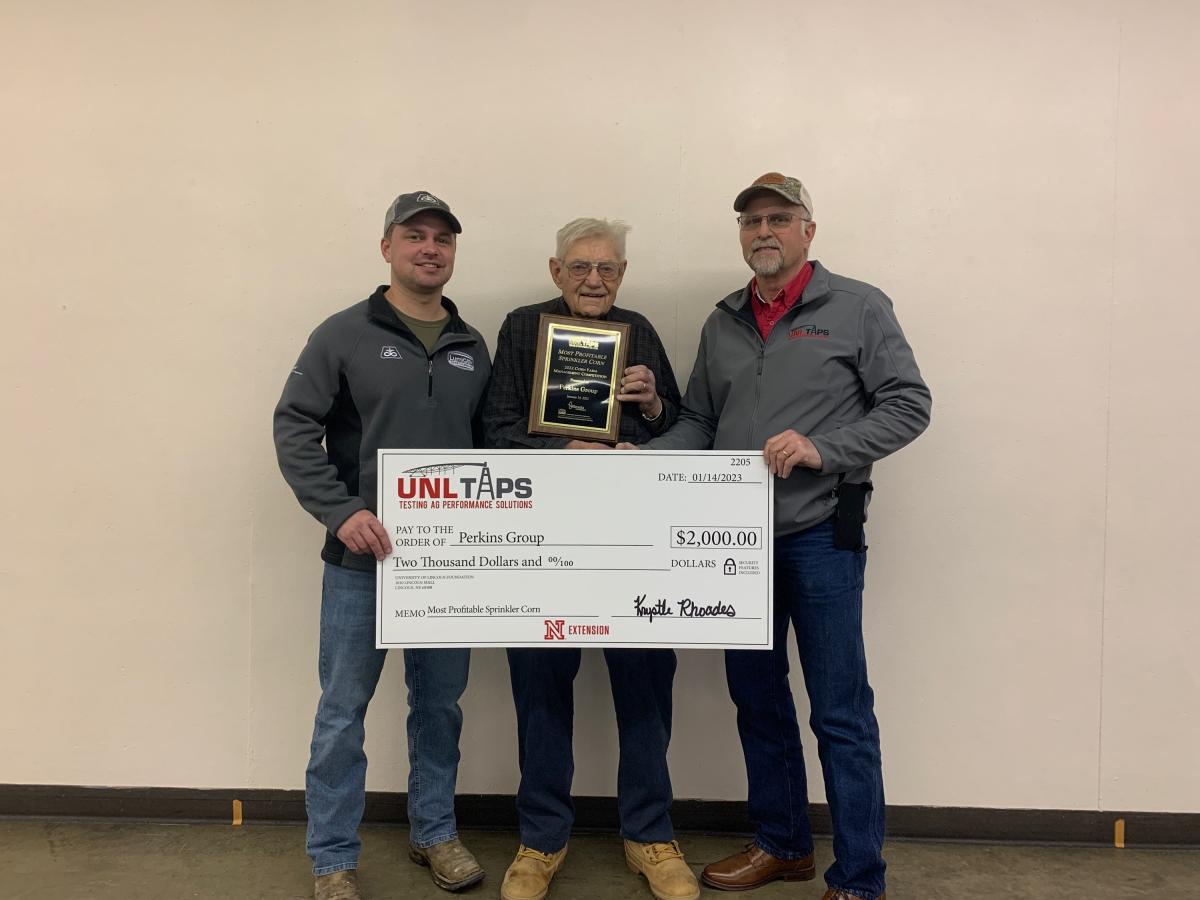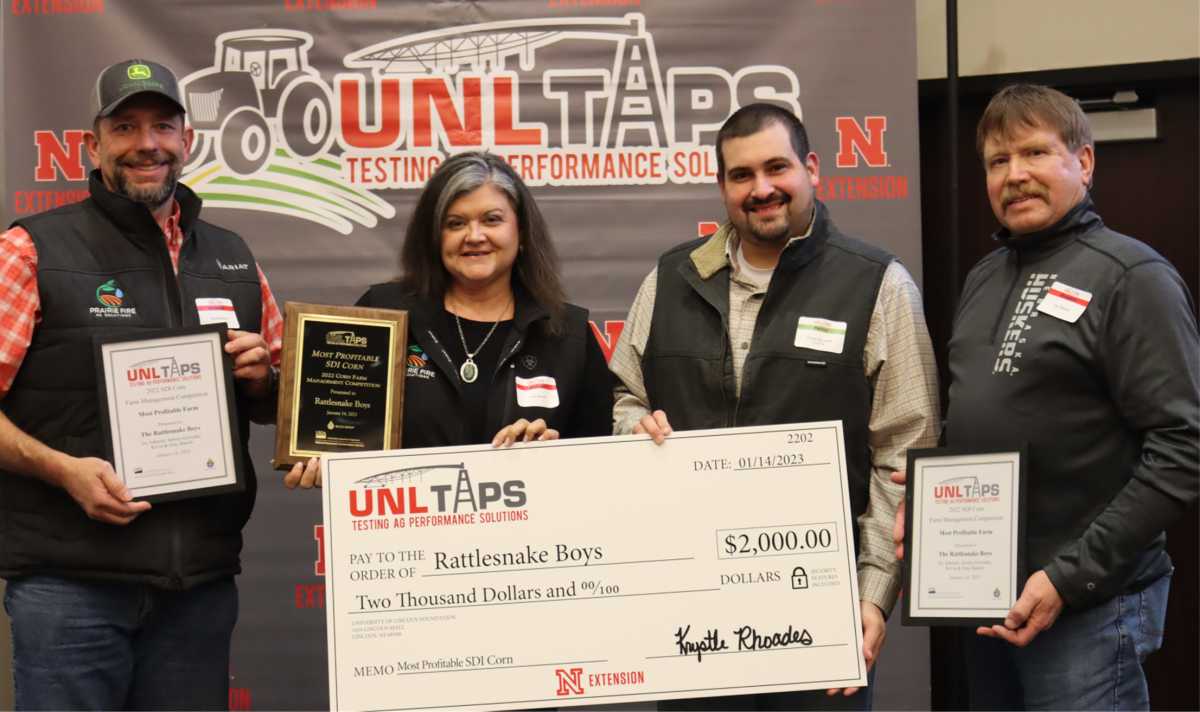By: Matt Stockton & Tessa Burford, TAPS Team Members
The Testing Ag Performance Solutions (TAPS) program’s 2022 competitions concluded at the annual awards banquet, held on Saturday, January 14, 2023, in Kearney, NE. More information on the annual event can be found at this link. During the celebratory evening, multiple awards were given to winners across the contests of sprinkler corn, Subsurface Drip Irrigated (SDI) corn, and sorghum in the categories of Greatest Grain Yield, Highest Input Use Efficiency, and Most Profitable. Specifically looking at the two corn competitions, (sprinkler and SDI), let’s take a closer peek at how the two Most Profitable teams earned their top spots.
Farm 15, also known as The Perkins Group, was the most profitable farm in this year’s sprinkler corn competition. Conceptually, the idea of profit is simple: total revenue minus total cost equals total profit. Looking a little deeper, it is clear that revenue has two components: 1) yield, and 2) grain value or price. We also know that cost components or inputs, such as herbicide, equipment, fertilizer, water, etc., drive both expense and yields. So, how did the 2022 winner do in these areas? Farm 15 had the fourth highest revenue per acre of $1,879, which came from a yield of 249.2 bushels per acre. For comparison, the first highest yielding farm (Farm 24) produced 270.6 bushels per acre, making a difference of 21.4 bushels, and had a net revenue of $1,889 per acre, or $9.82 per acre more than Farm 15. Farm 24’s cost per acre was $77.67 per acre more, however, giving the highest yielding farm a lower profit by $67.70 per acre. The second highest ranked farm for profit was Farm 6. This farm had $16.11 per acre less profit than the winner. The slightly lower yields and higher costs of Farm 6 were the cause of the difference.
The Perkins Group is from around the Grant, NE, area and included team members Brent Gloy, Bruce Young, Curt Richmond, Jeremy Hagan, Nick Turner, Pat McGreer, Shawn Turner, Ted Tietjen, and Troy Kemling. This was the sixth year the group competed, and their second time winning Most Profitable, although some team members do change yearly. Member Nick Turner indicated that the market conditions led the way to their profitability: “Strong basis through harvest really helped us capture a good price for our crop,” said Turner. The Perkins Group utilized two, big, end of season spot (cash) sales of 373,800 bushels each, receiving their average revenue of $7.54 per bushel between the two.

Members of the Most Profitable team in the 2022 sprinkler corn competition, Nick Turner (left) and Ted Tietjen (center), pictured with TAPS team member, Chuck Burr (right).
Farm 8, also known as The Rattlesnake Boys, was the most profitable farm in this year’s SDI corn contest. Farm 8 had the highest revenue per acre of $2,198, which came from the fourth highest yield of 276.6 bushels per acre. For comparison, the first highest yield (Farm 5) was 288.9 bushels per acre, making a difference of 12.3 bushels. The highest yielding Farm 5 had a total revenue of $2,100 per acre, $97.30 per acre less than Farm 8, which also had the advantage of a lower cost per acre by $51.54. The second highest ranked farm for profit was Farm 3 with $1,089 per acre, or $103.23 less profit than Farm 5. The revenue difference between Farm 3 and the winning Farm 8 is Farm 3’s lower yields, (8.1 bushels per acre less than Farm 8), and a lower average price received, ($0.46 per bushel less than Farm 8). Farm 3 made a good showing in costs per bushel produced, however, which was $3.44 per bushel, about $0.20 per bushel or $82.38 per acre less than the Most Profitable award-winning Farm 8.
From Wood River, NE, the Rattlesnake Boys have competed in the SDI corn contest for four years, now. The team includes members Jay Johnson, Amy and Kevin Harsch, and Jeremy Gewecke. This year, the team utilized multiple contracting methods, including futures, basis, and a spot (cash) sale. Additionally, various delivery points came into play. Standout components of their grain marketing were two large contracts, one a basis of 165,000 bushels, and the other a large, post-harvest spot (cash) sale for 111,600 bushels, as well as the season-long method of hedging via futures. Overall, their average revenue received was $7.95 per bushel.

Members of the Most Profitable team in the 2022 SDI corn competition, Kevin & Amy Harsch (left & center left), and Jay Johnson (right), pictured with Taylor Reynolds of Eco Drip (center right).
Looking at the results from a revenue and costs perspective can be helpful in judging a farm’s profit performance. This deeper dive into the contributing factors of revenue, costs, and yield provide a context to understand why a particular team won the contest. Revenue is dependent on grain price and quantity produced (yield), whereas yields are affected by inputs, such as herbicide, equipment, fertilizer, water, etc. Input combination and timing are key to determining costs, directly, and revenue, indirectly. One for sure way to win in this part of the competition is to have the lowest costs per bushel, the most bushels per acre, and the highest price received for each bushel. Contest winners of Most Profitable are generally balanced among the three profit components. The question everyone asks is how did this year’s winner accomplish overall Most Profitable? The profitability winner is often not the highest yield, highest market price, or lowest cost, but the team that has respectable yields, a solid market price, and low cost per unit. In the 2022 sprinkler corn contest, Farm 15 was ranked fourth in revenue per acre, fourth in lowest costs per bushel produced, and fifth in yield per acre. In the 2022 SDI corn contest, Farm 8 was the top marketer, and ranked in the top four in yield, and the top seven in cost per bushel. Ultimately, the goal is to have the lowest cost per bushel in combination with the highest in both revenue and yield per acre.